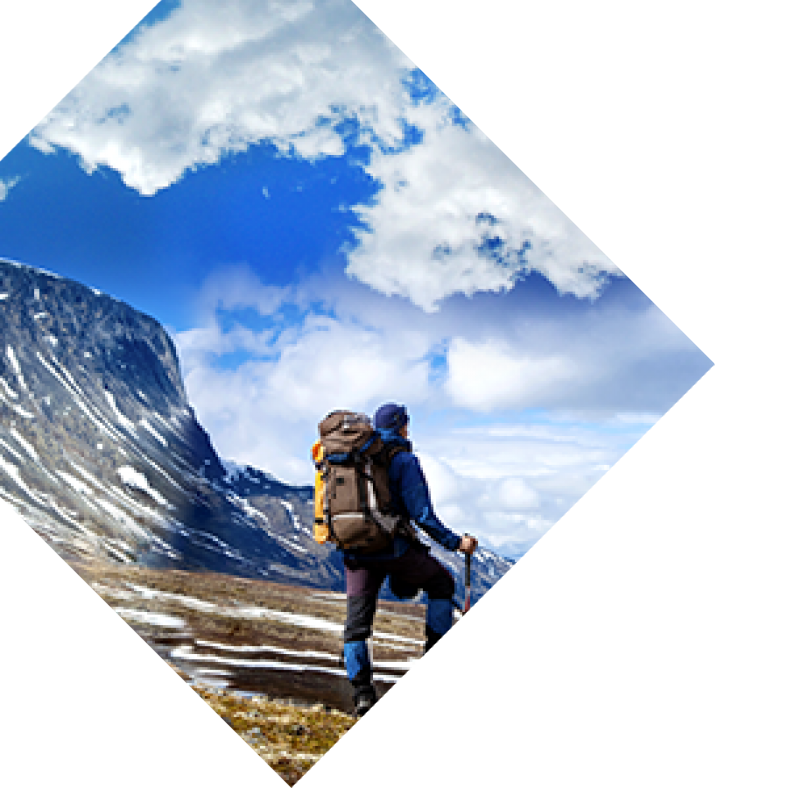When I began my thru-hike on the Appalachian Trail, I already had a few previous section hikes under my belt. I was lucky enough to know what gear was essential and what I could live without. However, being a recent college grad, my budget was not as ample as I would have liked. Thus, I began my 2000-mile journey with a five-pound, two-person tent and a heavy, synthetic sleeping bag. I already owned these items and I didn’t want to splurge on anything new. The gear I had was sufficient to get me through the unpredictable weather, but it wasn’t doing my back any favors. Finally, around the halfway point, I upgraded my set-up to a backpacking hammock and a lighter sleeping bag. I also ditched a few unnecessary layers of clothing that I hardly ever wore. I cut about seven pounds of pack weight. It doesn’t sound like a lot, but since I was carrying it for 10 hours a day, it made all the difference. To make sure you don’t carry around too much unnecessary weight, I’ve put together an Appalachian Trail gear list of must-haves, as well as some items you may not need, but it might be fun to pack anyway!
Considerations
Before you can jump into a packing checklist, you have to go over the considerations, as these categories will impact what ultimately finds a home in your pack.
Base Weight
Base weight refers to everything in your pack that is not food or water. One of the most important things to think about when shopping for backpacking gear is how much everything weighs. Remember, you will be carrying it on your back for the entire hike. Try to shoot for a base weight of 20 pounds or less. With how light backpacking gear has become in recent years, this is a relatively achievable goal. If you really like to nerd out about gear, you can get into ultra-light backpacking. Ultra-light refers to using the simplest, lightest gear out there and typically implies a base weight of 10 pounds or less. My general rule with base weight is to bring only items that are absolutely essential. I make an exception for one comfort or bonus item, which is usually my Kindle because I love to read. The biggest gear mistake I made on my first backpacking trip was bringing too many unnecessary items. My pack ended up being too heavy for me and it was ridiculously uncomfortable to carry. I mailed home an entire box of stuff at the first post office I came to.
Budget
Buying an entirely new set of backpacking gear isn’t cheap. If you’re new to the sport and on a budget, price will likely dictate which gear you select. With lots of research, frugal planning, and willingness to get secondhand gear, you could likely outfit yourself for $600 or less. On the flip side of things, you could spend several thousands of dollars if you want the highest-quality gear on the market. When I first got into backpacking, all of my gear was on the cheaper and heavier end of the scale. I still had a blast on the Appalachian Trail, even if it was more physically difficult than it needed to be. The good news is the gear you bring does not determine the experience you will have, it just makes life on the trail a bit easier. Over the years, as I continued to backpack and my budget expanded, I slowly upgraded my gear one purchase at a time. Go with the less expensive items when you’re just getting into the sport and unsure of whether you will like it. You can always get better gear in the future if you find that you still enjoy backpacking.
Weather
The weather will help you decide what type of gear you need to bring along. If you are attempting to thru-hike the Appalachian Trail, you will need to be prepared for everything from snow to rain storms to heat waves. Use the list below as your guideline. If you are planning a shorter section hike, look up the average temperatures for the region you’re going to for your time frame. Of course, if you are hiking in the summer, you won’t need the items from the “cold weather clothes” category.
Appalachian Trail Gear
- Backpack. Your backpack is key because it is your home that you carry with you. Comfort is everything. I would suggest buying the rest of your gear first then selecting a pack. This way you will know how much capacity you need. For the Appalachian Trail, most hikers will need a pack that holds between 50 to 65 liters. If you are going lightweight with your gear, then you can get away with less.
- Recommended backpacks: Osprey, Granite Gear Crown
- Shelter. While there are volunteer-built shelters (known as “lean-tos”) all along the Appalachian Trail, it is advisable to bring your own form of shelter. In bad weather, hikers quickly claim spots in the lean-tos and often there is not enough space for everybody. Tents are the most common shelter carried by hikers. Tarps are a good option if you are trying to keep a light base weight, and they can be set up with trekking poles or tied to trees. My personal favorite shelter for the Appalachian Trail is a hammock because they are so comfortable and trees are abundant for set-up.
- Recommended shelters: Hennessy Hammock Explorer Ultralite Asym Zip
- Sleeping bag. A 20-degree sleeping bag will be sufficient. Some hikers choose to have two bags, a 20-degree bag for spring and fall and a 40-degree bag for summer. They mail home the bag they are not using. Down sleeping bags are the lightest option, but synthetic bags are less expensive. If you plan on purchasing only one sleeping bag, go for the warmer option and unzip it while you sleep in the hot months.
- Recommended sleeping bags: Feathered Friends
- Sleeping pad. Inflatable sleeping pads are the most comfortable option. However, there is no risk of puncturing foam pads.
- Recommended sleeping pads: Therm-a-Rest NeoAir XLite and Z Lite.
- Cookware. Fuel canister stoves are the easiest-to-use option out there, and fuel canisters can be purchased in most trail towns. You will also need a cooking pot. If you are planning on cooking only for yourself, a one-liter pot (or slightly smaller) will be sufficient.
- Recommended Stove: MSR Pocket Rocket
- Water treatment and water bottles. Treating water from springs and streams is critical to avoiding getting the dreaded giardia. UV light pens are the fastest option, while filters and drops are the cheapest. Bring water bottles or a water bladder with capacity for carrying three liters.
- Recommended water treatment: SteriPEN Adventurer, Sawyer MINI water filter
- Headlamp. You will use your headlamp basically every night. This is one of those items where you get what you pay for. More expensive headlamps will be brighter and have more settings, while the opposite is true for cheaper ones. I use a headlamp that’s moderately priced because the simpler design weighs less than their more expensive counterparts.
- Recommended headlamp: Petzl Zipka
- Guidebook. The trail is obvious and adequately marked, so there’s no need for a map and compass. Get a guidebook that can inform you where to expect campsites, water sources, and trail towns.
- Recommended Guide: The A.T. Guide by David Miller
Clothes and Footwear
- Hiking shoes. Trail runners are becoming as commonly used as hiking boots. For the Appalachian Trail, I prefer trail runners because they are less likely to lead to blisters or sore feet. However, for hikers who easily roll their ankles, I would suggest a pair of hiking boots with ankle support. Also consider if you want to bring a pair of camp shoes. On one hand, they are nice to have because you can air out your feet and give them a break from your boots. On the other hand, if you want to cut as much pack weight as possible, you probably don’t need a pair.
- Recommended hiking shoes: Salomon Speedcross 3 GTX® Shoe, Merrell Moab GORE-TEX Mid Boot
- Hiking clothes. Bring along shorts or hiking pants and a synthetic or merino wool shirt. I typically bring only one of each because I don’t like carrying the extra weight. But full disclosure: It does get smelly wearing the same outfit for a week between washes. It’s a personal call if you want an extra set of hiking clothes or not.
- Rain jacket. It rains quite a bit on the Appalachian Trail. Invest in a good rain jacket to keep you dry. They do a good job of trapping body heat, as well. I wore mine on chilly days and most nights around camp.
- Recommended rain jackets: Outdoor Research Foray Jacket, Marmot Minimalist Jacket
- Base layers. Base layers will keep you warm at night and around camp. On especially chilly days, you can layer them with your regular hiking outfit. Go for something synthetic or merino wool.
- Socks. Bring along two or three pairs of wool hiking socks. While I ultimately wear them several times between trips to the laundromat, I rotate my socks every day to give them a chance to fully dry out.
- Recommended socks: Darn Tough, SmartWool
Cold Weather Clothes
Hikers typically pack additional clothes for cold weather. In the summer, hikers can mail the cold weather clothes back home to cut pack weight. Plan to mail any extra clothes in Damascus, Virginia, and have them sent back to you in Hanover, New Hampshire; vice versa if you are hiking north to south.
- Warm hiking clothes. Shorts and tank tops aren’t going to cut it in cold weather. Have pants and a long-sleeve shirt to wear while hiking. I rotate my base layer outfit into use as my regular hiking outfit in cold weather.
- Down jacket or fleece. Stay extra toasty at night by having additional layers. A down jacket will be warmer and lighter. Fleece jackets will be cheaper, and you can usually find a deal on them at the thrift store. If you are expecting conditions below freezing, go ahead and bring both a down jacket and a fleece.
- Recommended jacket: Patagonia Refugitive Jacket
- Rain pant. In cold weather, staying dry is critical to preventing hypothermia. It’s not uncommon to see hikers outside of laundromats in trail towns wearing their rain layers while everything else gets washed.
- Recommended rain pants: Outdoor Research Foray Pant, Marmot Minimalist Pant
- Hat and gloves. Keep those ears and fingers warm.
- Recommended gloves: Seirus GORE-TEX Xtreme All Weather™ Glove, Outdoor Research Stormcell™ Glove
- Sleeping bag liner. Depending on the degree rating of your sleeping bag, you may want to consider getting a sleeping bag liner to keep you extra warm during low temperatures. I get cold easily at night, so this is usually a must for me.
- Recommended sleeping bag liner: Sea to Summit Reactor Thermolite
List of gear you probably don’t need to pack
These are the unnecessary items that are often brought along.
- Large knife or machete
- Bear spray
- Multiple books
- Solar charger (The Appalachian region is so cloudy and tree-covered, solar chargers are often ineffective.)
- Rope
- Topography maps and compass
- Pillow
- DSLR camera (unless you have professional-level photography skills)
- Too many extra clothes
- Anything that isn’t on this list and you have to rationalize bringing it by saying, “Just in case.”
When planning a hike on the Appalachian Trail, gear is perhaps the thing you will dedicate the most research to. Whether you are doing a 2,000-mile thru-hike or going out for a weekend, you will need to put careful consideration into each item you bring along. With diligence and self-control in regard to over-packing, you can find a base weight you are happy with. If you’re a backpacking beginner or just starting your Appalachian Trail research, check out my article where I answer frequently asked questions about the AT.



